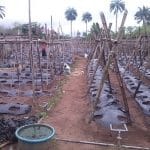If you have ever tried farming on a plot of land (120x60ft) or more, you’ll agree with me that weeding with hoes is no easy task. It is back- and waist-breaking! If you decide to employ laborers to help you out, they’ll charge you about N7000 per plot (depending on your location). This shows how important it is for you to find ways of cutting weeding cost. And that’s exactly what you’re about to learn.
So how do we go about this? The method we’re going to look at is called the stale seedbed method. Here is how it works. Make your seedbed, ridges or hills (I like working with ridges because it makes operations like fertilizer application or spraying insecticides and fungicides easier). After making your ridges, don’t sow your seeds or transplant yet. Allow about 2 weeks to pass to allow the first flush of weeds to grow.
>>>>>> [Read more…] <<<<<<
